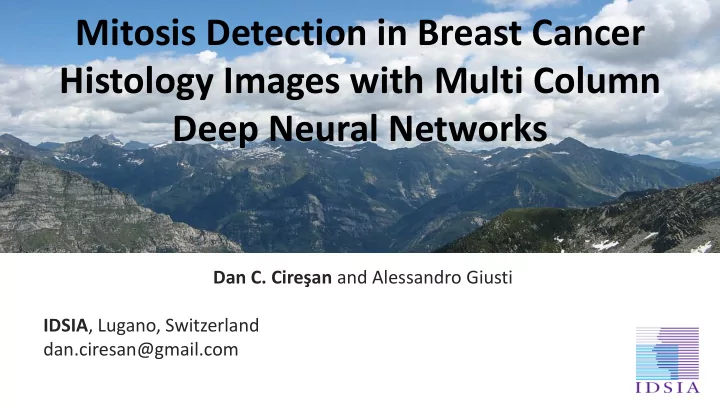

Mitosis Detection in Breast Cancer Histology Images with Multi Column Deep Neural Networks Dan C. Cireşan and Alessandro Giusti IDSIA , Lugano, Switzerland dan.ciresan@gmail.com
DNN for Visual Pattern Recognition • One of the first to have a DNN implemented on GPU (CUDA), 2009 • We applied DNN on a plethora of pattern recognition tasks
Why mitosis detection? • Mitosis detection is a challenging visual pattern recognition problem • No histology or medicine background • ICPR2012 & MICCAI2013 competitions: – 2012 ICPR Competition: 50 images, 300 mitosis; 17 teams – 2013 MICCAI Competition: ~600 images, 1157 mitosis; 14 teams
Deep, Convolutional Neural Network
http://ipal.cnrs.fr/ICPR2012/ D. Ciresan et al. - Mitosis Detection in Breast Cancer Histology Images using Deep Neural Networks, MICCAI 2013
Data Description 2048x2048 px (0.5 x 0.5 mm)
Method • We use a powerful pixel classifier (a Deep Convolutional Neural Network) to detect pixels close to mitosis centroids • Input: raw pixel values in a window (no features, no preprocessing) • Output: probability of central pixel being close to a mitosis centroid
Network Architecture Feature extraction layers Classification layers 7.5K weights 6.7K (13.4K) weights 4.7M connections 6.7K (13.4K) connections
Training samples & time 66K positive training samples (all pixels closer than 10 px to a mitosis) 2M negative training samples Or up to 3 days on a GPU
Approach Overview
Data and nets • Training set (263 images with ground truth, coming from 12 patients) – We split the training set in two sets T1 (174 images) and T2 (89 images) • Initially we trained nets on T1 and validated on T2 • Then we trained nets on T1+T2 and applied them to T3 (our submissions) • Evaluation set (295 images without ground truth, coming from other 11 patients) – Used exclusively for testing – Denoted as T3 (ground truth known only by the organizers)
Results for net n10 • Trained on T1. Results on the validation set (T2) with 8 variations • Ground truth is used to decide on which threshold to use when training on T1+T2 • T2: (max F1 ~0.64, F1 at 0.4 ~0.6) T3: F1 at 0.4 0.505 • We either overfitted on T2, or T2 and T3 are quite different (or both) T2 T2
Our submissions • n10e06 + n30e05 + n31e02, 8 variations, T1+T2 – t=0.45 -> F1-score = 0.593 – t=0.35 -> F1-score = 0.460 – t=0.5 -> F1-score = 0.611 • n10e06, 8 variations, T1, t=0.4 -> F1-score = 0.505
Results overview on the evaluation dataset Green: True Positives Red: False Positives Cyan: False Negatives
n10 on validation data (T2)
Detection results D. Ciresan et al. - Mitosis Detection in Breast Cancer Histology Images using Deep Neural Networks, MICCAI 2013
Quantitative Results F1 score: 0.78
Assessment of Mitosis Detection Algorithms 2013 - MICCAI Grand Challenge
http://amida13.isi.uu.nl/ • more training data – 2012 ICPR Competition • 50 images, 300 mitosis, 17 teams – 2013 MICCAI Competition • ~600 images, 1157 mitosis, 14 teams • test data is more difficult
Results
Reannotation experiment 90 histologists Mitoses 80 Non-mitoses reannotated 30% of 70 all our “False 60 50 Positives” as actual % 40 mitoses they missed 30 during the original 20 annotation 10 0 IDSIA (N=208) DTU (N=397)
How do you compare with machines? http://bit.ly/YUYQFG A. Giusti at al. - A Comparison of Algorithms and Humans for Mitosis Detection, ISBI 2014
Results of Mitosis Detection Competitions ICPR 2012 MICCAI 2013 1 0.7 0.6 0.8 0.5 F1 score F1 score 0.6 0.4 0.3 0.4 0.2 0.2 0.1 0 0 IDSIA IDSIA other entries other entries
Conclusions • No need to extract handcrafted features: the network learns powerful features by itself • Big deep nets combining CNN and other ideas are now state of the art for many image classification, detection and segmentation tasks • Our DNN won six international competitions • DNN can be used for various applications: automotive, biomedicine, detection of defects, document processing, image processing, etc. • DNN are already better and much faster than humans on many difficult problems • GPUs are essential for training DNN. Testing can be done on CPU. • More info: www.idsia.ch/~ciresan dan.ciresan@gmail.com
Looking for new projects • Industry • Academic – Unrelated fields: biomedicine, psychology, finance, literature, history – Vision for robotics www.idsia.ch/~ciresan dan.ciresan@gmail.com
Other projects
Neural Networks for Segmenting Neuronal Structures in Electron Microscopy Stacks – ISBI 2012 Training data: 30 labeled 512x512 slices Test data: 30 unlabeled 512x512 slices CONNECTOMICS
Retina vessel segmentation - challenging problem - clinical relevance (e.g. for diagnosing glaucoma) - state of the art results for DRIVE and STARE datasets - better than a second human observer DNN
Trail Following Problem MAV collaboration with Jérôme Guzzi, Alessandro Giusti, Fang-lin He, Juan P. R. Gómez
Recommend
More recommend